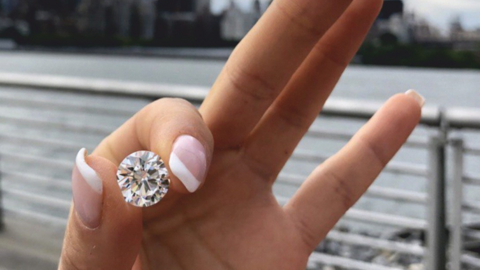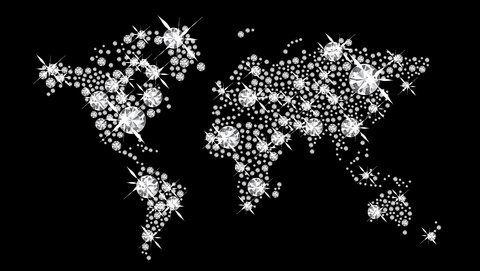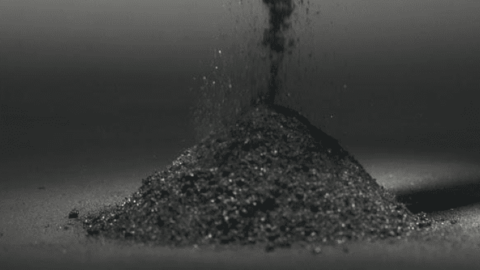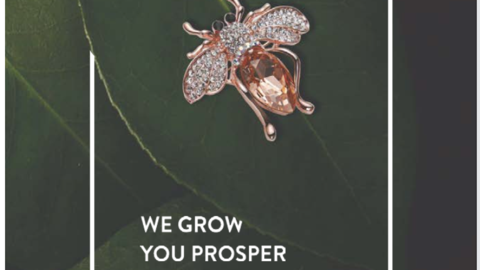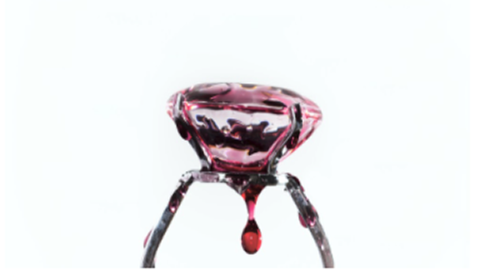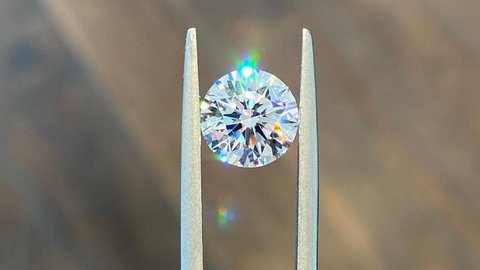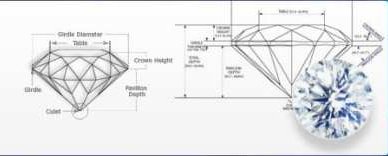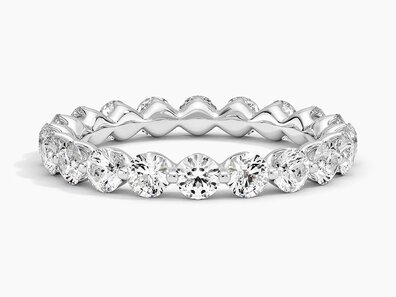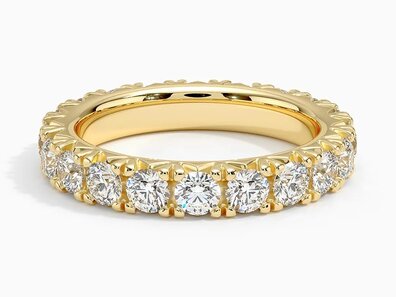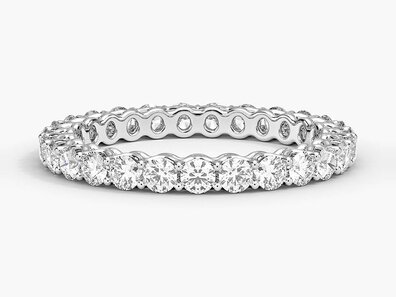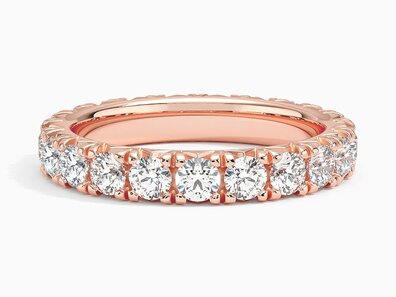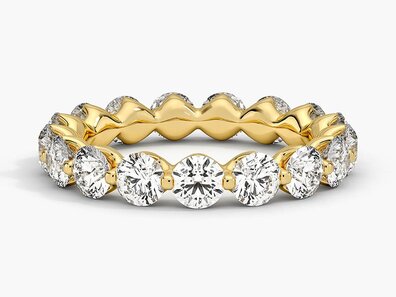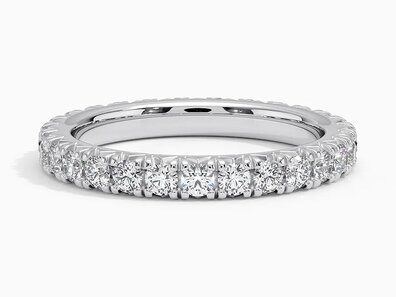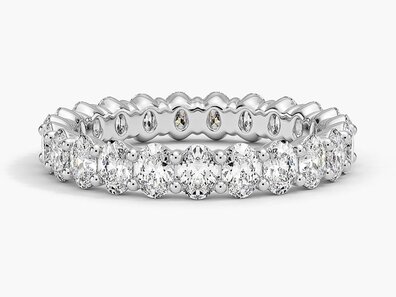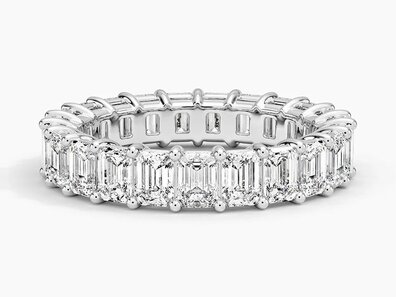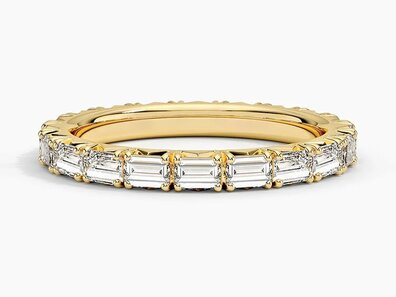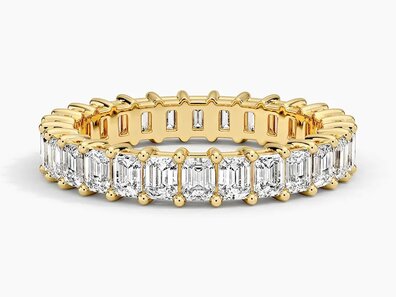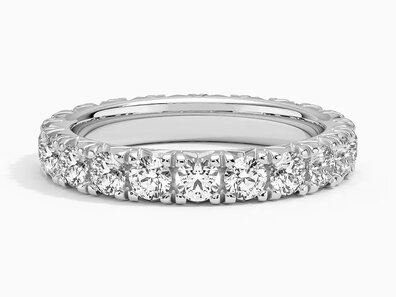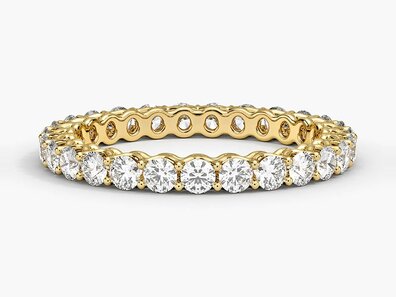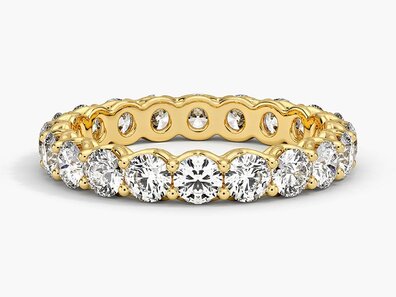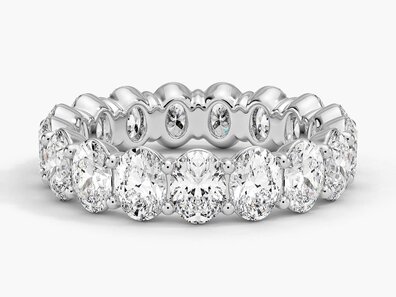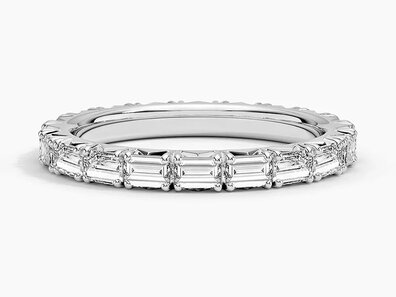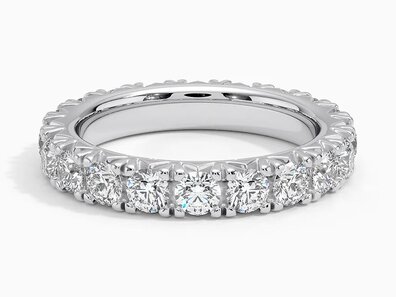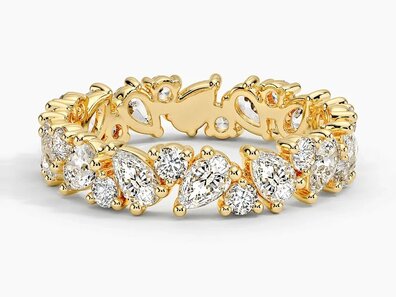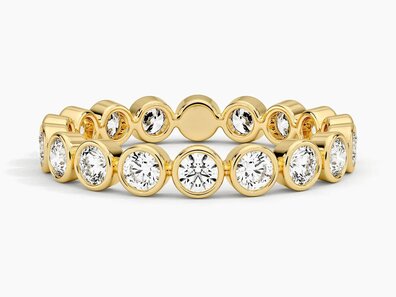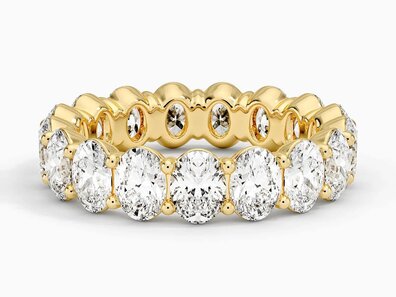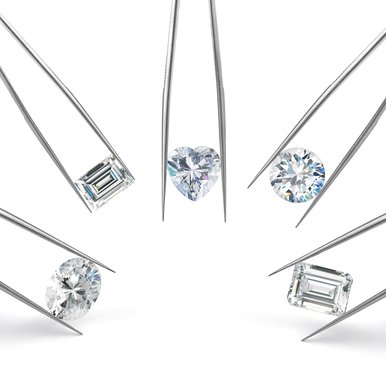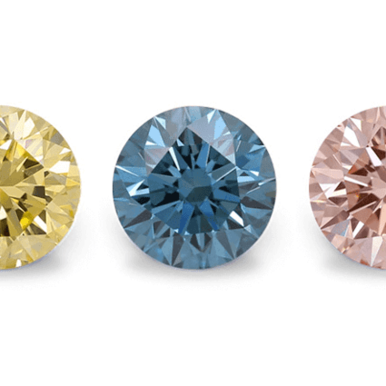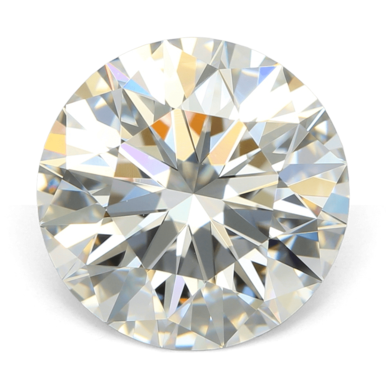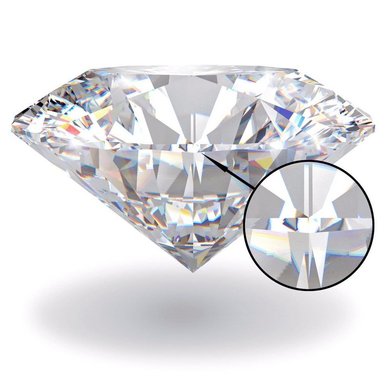Eternity Lab Grown Diamond Wedding Rings - Premium CVD & HPHT
Author: Alex K., CMO at Labrilliante Updated: 2025-12-09 Reading Time: 12 minutes
Lab-grown eternity bands deliver celebrity-level designs for $3,000-$5,000 versus $30,000+ for mined equivalents—70-90% savings without compromising brilliance or durability. CVD and HPHT technologies enable perfect diamond matching impossible with natural stones. Manufacturer-direct pricing eliminates 400-500% retail markups while maintaining IGI and GIA certification standards. Conflict-free provenance and reduced carbon footprint align luxury with ethical wedding trends.
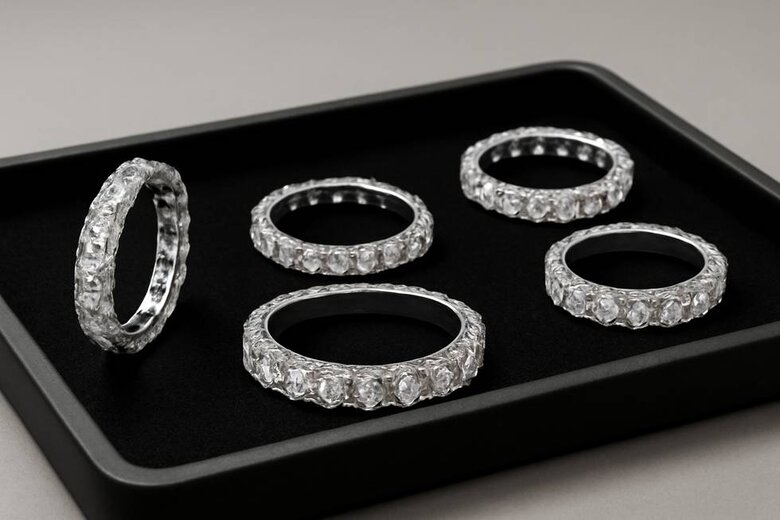
Wedding jewelry choices now carry unprecedented weight—couples demand symbols of eternal love that also reflect personal values around sustainability and ethical sourcing. Eternity lab grown diamond wedding rings represent this cultural shift, merging technological innovation with timeless romantic symbolism. This guide reveals how premium CVD and HPHT diamonds make celebrity-inspired designs accessible, why manufacturer-direct pricing transforms luxury economics, and which technology best matches your aesthetic vision. You'll discover the engineering precision behind continuous diamond settings, sustainability advantages over traditional mining, and practical strategies for maximizing value without compromising on the forever promise your ring represents.
The Resale Reality: Why Some Buyers Still Choose Mined Diamonds
Lab-grown diamonds currently carry lower resale values than mined equivalents—a legitimate concern for buyers viewing jewelry as financial investment rather than purely symbolic purchase. The secondary market hasn't fully matured for laboratory-created stones. Pawn shops and traditional jewelers often refuse lab-grown diamonds or offer minimal buyback prices compared to natural stones with comparable certification grades.
This investment angle holds merit for specific buyer profiles. Collectors acquiring high-carat statement pieces or families treating jewelry as portable wealth might rationally prefer mined diamonds despite premium costs. In economic uncertainty scenarios where liquidation becomes necessary, natural diamonds maintain established resale channels developed over decades.
However, this counterargument fails for most wedding jewelry purchases. Eternity bands rarely get resold—they represent permanent commitment symbols passed down through generations rather than speculative assets. The 70-90% upfront savings with lab-grown alternatives dramatically outweigh theoretical future resale differences for couples prioritizing current affordability and ethical sourcing. Besides, mined diamond resale values typically recover only 20-40% of original retail prices anyway. What looks like preserved value is actually massive depreciation—just less severe than lab-grown depreciation. For wedding bands worn daily and cherished indefinitely, immediate savings and conflict-free provenance deliver greater practical value than hypothetical resale scenarios most couples never encounter.
Celebrity-Level Eternity Bands: Meghan Markle and Jennifer Lopez Style for 90% Less
Celebrity eternity bands featuring continuous diamonds cost $30,000+ with mined stones, but lab-grown alternatives deliver identical brilliance for under $5,000. Game-changing savings. Meghan Markle's pavé style and Jennifer Lopez's shared-prong designs become accessible through CVD and HPHT technology.
The engineering challenge lies in precision diamond matching. Celebrity-level designs demand exceptional consistency in color, clarity, and cut quality. Traditional mined diamond sourcing made this matching process extremely expensive.
Lab-grown technology solves the scarcity problem. CVD and HPHT processes create diamonds with controlled characteristics, enabling perfect matching at manufacturer-direct pricing. This eliminates the primary cost driver while maintaining optical and physical properties identical to natural stones.
| Celebrity-Inspired Style | Ring Specifications | Mined Diamond Cost | Lab-Grown Diamond Cost | Your Savings | Percentage Saved |
|---|---|---|---|---|---|
| Meghan Markle Micro-Pavé Eternity Band | 1.0 ct total weight, F-G color, VS clarity, Platinum setting, 40+ diamonds | $32,500 | $4,200 | $28,300 | 87% |
| Jennifer Lopez Shared-Prong Eternity Band | 2.5 ct total weight, F color, VS1 clarity, Platinum, 0.20 ct per stone, 12-13 diamonds | $48,750 | $4,850 | $43,900 | 90% |
| Jennifer Lopez Premium Bold Style | 3.0 ct total weight, E color, VVS2 clarity, Platinum, 0.25 ct per stone, 12 diamonds | $67,500 | $5,400 | $62,100 | 92% |
| Royal Family Graduated Eternity Band | 1.8 ct total weight, G color, VS2 clarity, Platinum, graduated sizing 0.10-0.15 ct | $38,200 | $3,850 | $34,350 | 90% |
| Delicate Micro-Pavé (Meghan Style - Half Eternity) | 0.50 ct total weight, F color, VS clarity, Platinum, 20+ diamonds | $18,500 | $2,400 | $16,100 | 87% |
| Bold Statement Shared-Prong (JLo Style - Half Eternity) | 1.5 ct total weight, F color, VS1 clarity, Platinum, 0.20 ct per stone, 7-8 diamonds | $29,250 | $3,200 | $26,050 | 89% |
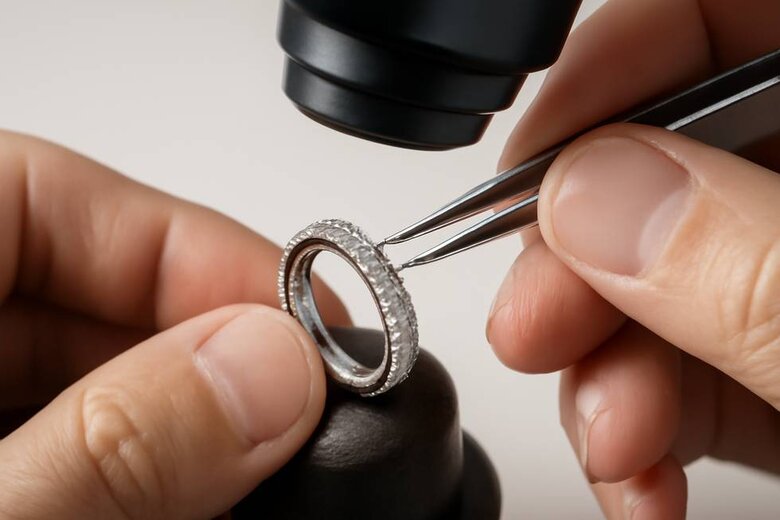
Meghan Markle Eternity Ring Lab Grown Alternative Under $5,000
The Duchess favors micro-pavé bands with approximately 1.0 carat total weight in F-G color, VS clarity diamonds set in platinum. Delicate appearance. Complex engineering underneath.
Micro-pavé requires extraordinary precision. Each diamond must align perfectly to create seamless light reflection. CVD technology excels here because controlled growth environments produce consistent crystal structure with minimal internal stress.
The analogy? Semiconductor manufacturing. Tiny variations in components create visible differences in final performance. Through partnerships with jewelry professionals, refined micro-pavé techniques now match royal jewelry standards while maintaining ethical transparency.
Trade-off consideration: Micro-pavé needs gentler handling during daily wear, but delivers unmatched continuous sparkle.
Jennifer Lopez Eternity Band Affordable Version with Full Circle Diamonds
Lopez-style bands feature 2-3 carat total weight with larger individual stones (0.15-0.25 carat each) in shared-prong settings. Bold statement pieces. Different philosophy than micro-pavé.
This design prioritizes individual diamond brilliance over continuous shimmer. Think precision gear systems - each diamond functions as a critical component where size consistency determines smooth operation.
HPHT technology historically produced larger rough crystals more efficiently. Modern CVD reactors now achieve comparable sizes. Dual CVD/HPHT capabilities enable exact matching of Lopez-style proportions with certified grades identical to celebrity pieces.
The trade-off? Shared-prong settings offer superior durability but create potential snag points during active wear.
Royal Family Style Eternity Band Lab Grown Design Options
British Royal Family traditions feature graduated sizing - larger center stones tapering toward smaller accents. Visual harmony through proportion. Historically exclusive to high-end dealers.
CVD growth allows precise control over crystal dimensions. This enables perfect size progressions impossible with mined diamond sorting. Pre-sorted graduated sets specifically designed for royal-style configurations include GCAL light performance certification for optimal brilliance matching.
"Leveraging advanced CVD technology not only enables us to match the royal jewelry standards in terms of aesthetic and quality but also allows for the customization of diamond sizes with unprecedented precision. This is akin to the precise control over electronic chip manufacturing, where every micron counts. In the case of lab-grown diamonds, this control translates to flawless size progression in eternity bands, a feature once only feasible with premium mined diamonds. Such precision ensures that each ring reflects an unmatched consistency and brilliance, previously exclusive to high-end luxury pieces."
Modern alternatives maintain traditional aesthetics while incorporating ethical considerations. The engineering trade-off involves complexity versus customization - graduated designs require sophisticated planning but enable personalized proportions impossible with standard sizing.
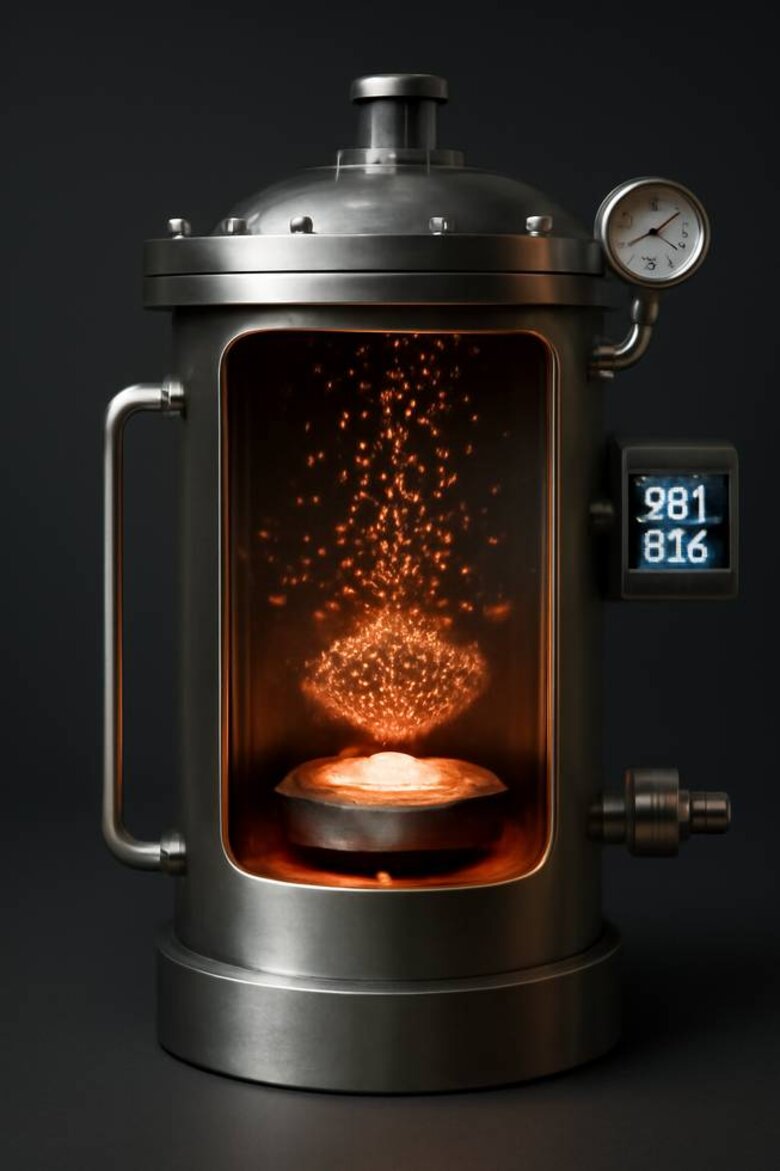
Sustainable Romance: Guilt-Free Luxury Eternity Bands with CVD and HPHT Technology
Lab-grown eternity bands eliminate environmental and ethical concerns while providing identical chemical, physical, and optical properties through controlled crystal growth. Pure sustainable luxury. This reflects evolving wedding trends where conscious consumption aligns with personal values.
Here's the fundamental choice: tradition versus innovation. Mined diamonds carry historical associations, while lab-grown alternatives offer technological precision and ethical transparency.
In-house laboratory monitoring ensures each growth cycle maintains consistent quality parameters. This provides supply chain transparency impossible with traditional mining operations.
Conflict-Free Eternity Band Full Circle Diamonds Explained
Conflict-free certification guarantees diamonds originate from controlled laboratory environments rather than disputed mining regions. Zero exploitation involved. Full circle settings amplify this ethical foundation.
Think organic food production. Controlled growing conditions eliminate contamination while maintaining nutritional value. CVD reactors operate in sterile environments with precise temperature and pressure controls.
HPHT growth occurs in closed-system presses that replicate natural formation without environmental disruption. Through partnerships with IGI and GIA certification bodies, complete documentation tracks each diamond's laboratory origin.
The trade-off? Lab-grown diamonds require weeks of controlled growth compared to instantaneous extraction, but guarantee conflict-free provenance.
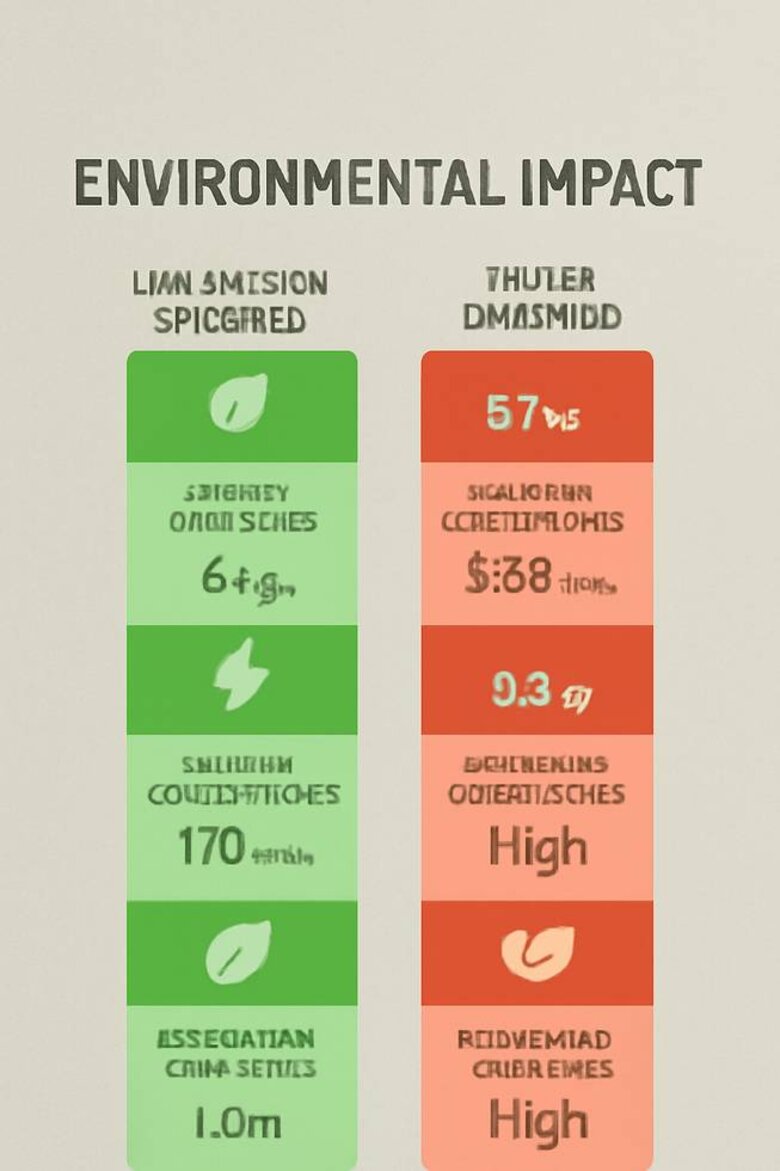
Eco-Friendly Eternity Ring for Millennial Wedding Trends
Millennial couples prioritize environmental sustainability, with lab-grown diamonds offering significantly lower carbon footprint compared to mined equivalents. Conscious luxury consumption. Environmental responsibility meets romantic symbolism.
The comparison resembles renewable energy adoption. Initial technology investment creates long-term environmental benefits. CVD growth consumes substantially less energy per carat than mining operations, while HPHT processes recycle industrial waste heat.
Dual technology approach optimizes energy consumption based on diamond specifications. This minimizes environmental impact while maximizing quality parameters.
What does this mean for couples? Authenticity over ostentation, where ethical sourcing provides emotional value beyond physical beauty.
Maximum Value Lab Diamond Eternity Rings: How Manufacturer Direct Saves 70-97%
Manufacturer direct purchasing eliminates retail markups, wholesaler margins, and distributor fees that add 400-500% to diamond costs. Massive savings unlocked. Premium eternity bands become accessible at 70-90% below traditional retail pricing.
Let's break down the economics. Traditional diamond distribution involves mines, rough dealers, cutting facilities, wholesalers, and retail stores. Each layer adds 50-100% markup without improving quality.
The integrated approach combines cutting, certification, and setting operations under single quality management. Supply chain savings pass directly to customers and B2B partners.
| Distribution Level | Traditional Retail Chain (Mined Diamonds) | Traditional Retail Chain (Lab-Grown Diamonds) | Manufacturer Direct (Lab-Grown Diamonds) |
|---|---|---|---|
| Production/Mining Cost | $2,000 per carat | $400 per carat | $400 per carat |
| Rough Dealer Markup | +60% ($3,200) | +50% ($600) | Eliminated ($0) |
| Cutting Facility Cost | +40% ($4,480) | +35% ($810) | In-House ($200) |
| Wholesaler Markup | +70% ($7,616) | +65% ($1,337) | Eliminated ($0) |
| Distributor Markup | +50% ($11,424) | +45% ($1,938) | Eliminated ($0) |
| Retail Store Markup | +100% ($22,848) | +90% ($3,682) | Direct Pricing ($0) |
| Final Consumer Price (Per Carat) | $22,848 | $3,682 | $600 |
| Total Markup from Production | +1,042% | +821% | +50% |
| Consumer Savings vs Traditional Retail | Baseline | 84% savings | 97% savings |
| Example: 2ct Eternity Ring (10 stones, 0.2ct each) | $45,696 | $7,364 | $1,200 |
Here's the reality: Professional buyers consistently choose manufacturer direct when equivalent quality and certification standards are maintained. This mirrors bulk purchasing in manufacturing - volume enables better pricing while maintaining individual product specifications.
CVD and HPHT advantages compound with direct purchasing benefits. Laboratory production costs remain constant regardless of retail markup. Economic efficiency resembles software distribution - reproduction costs approach zero while development investment stays fixed.
The operational trade-off? Maintaining extensive inventory requires capital commitment but ensures availability for custom designs without sourcing delays.
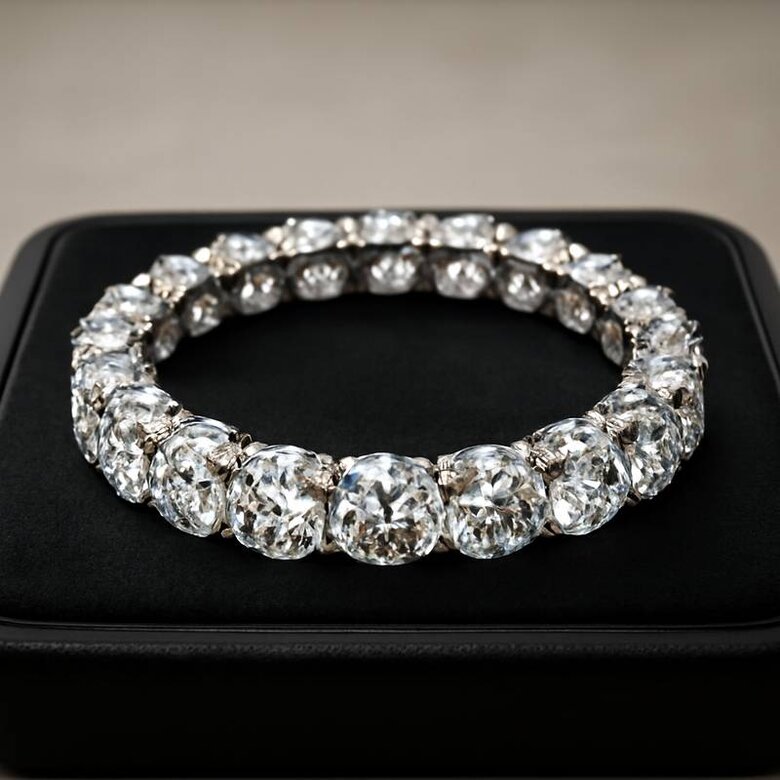
Forever Promise Symbolism: What Full Circle Diamond Settings Mean for Eternal Commitment
Full circle diamond settings create unbroken light reflection around the entire circumference, symbolizing eternal love without beginning or end. Pure geometric perfection. Forever promise symbolism extends beyond aesthetics to represent infinite commitment.
Think precision bearing systems. Continuous contact points ensure smooth operation. Each diamond position contributes to overall light performance, creating cumulative brilliance exceeding individual stone contributions.
Historical eternity rings date to ancient Egypt, where circular jewelry represented eternal cycles and divine perfection. Full circle setting expertise ensures proper diamond alignment and spacing for optimal light transmission.
CVD and HPHT diamonds enhance forever promise meaning through technological permanence. Laboratory-grown crystals exhibit identical atomic structure to natural diamonds. The physical symbol maintains its properties indefinitely.
What's the deeper connection? Controlled creation and intentional commitment resonate with couples valuing precision in relationship building.
Full circle configurations amplify light performance through internal reflection between adjacent stones. This creates continuous fire and brilliance varying with hand movement - symbolizing dynamic relationships.
CVD vs HPHT Technology: Choosing the Best Lab Grown Eternity Band for Your Budget
CVD produces diamonds through chemical vapor deposition with superior color control, while HPHT uses high pressure and temperature for larger crystals with exceptional clarity. Different strengths. Both create genuine diamonds with identical properties.
Technology selection depends on design priorities and aesthetic preferences rather than quality superiority. CVD diamonds typically exhibit better color consistency due to controlled gas environment chemistry - ideal for eternity bands requiring precise color matching.
HPHT growth often produces larger rough crystals with fewer inclusions. This enables better clarity grades but with slight color variation requiring careful sorting.
| Comparison Factor | CVD (Chemical Vapor Deposition) | HPHT (High Pressure High Temperature) |
|---|---|---|
| Growth Method | Layer-by-layer carbon atom deposition in controlled gas environment | Replicates geological formation using extreme pressure and temperature on carbon source |
| Growth Rate | 0.5-1.0mm per day (predictable and controllable) | 1.5-2.5mm per day (rapid crystallization) |
| Typical Growth Time (1 carat) | 4-6 weeks | 2-3 weeks |
| Color Control | Superior - 95% color consistency across batches, ideal for D-F colorless grades | Moderate - 70-80% consistency, may require careful sorting for color matching |
| Color Range Achievement | D-E: 85% success rate, F-G: 92% success rate | D-E: 65% success rate, F-G: 80% success rate |
| Clarity Advantages | VVS1-VS2 typical range, fewer metallic inclusions | IF-VVS1 achievable more frequently, exceptional clarity grades from larger crystals |
| Typical Clarity Distribution | IF: 5%, VVS: 45%, VS: 40%, SI: 10% | IF: 15%, VVS: 50%, VS: 30%, SI: 5% |
| Maximum Rough Crystal Size | 3-5 carats typical, up to 10 carats possible | 5-15 carats typical, up to 25+ carats achievable |
| Crystal Structure Uniformity | Highly uniform with predictable properties | Excellent but with minor variation in growth patterns |
| Optimal Applications for Eternity Rings | Full eternity bands requiring precise color matching across 15-25+ stones | Half eternity or statement designs with larger center stones (1.5-3ct each) |
| Cost Efficiency (1ct D VVS1) | $800-$1,200 per carat | $900-$1,400 per carat |
| Best Value Proposition | Color-critical matching applications, uniform smaller stones (0.3-1.0ct) | Clarity-focused designs, larger statement stones (1.5ct+) |
| Certification Standards | IGI, GIA, GCAL - identical grading standards | IGI, GIA, GCAL - identical grading standards |
| Physical Properties vs Mined | Identical: Hardness 10 Mohs, RI 2.42, thermal conductivity identical | Identical: Hardness 10 Mohs, RI 2.42, thermal conductivity identical |
| Recommended for Eternity Band Design | Full eternity with 20+ matched stones, pavé settings, channel settings | Statement eternity with 5-10 larger stones, prong settings, showcase clarity |
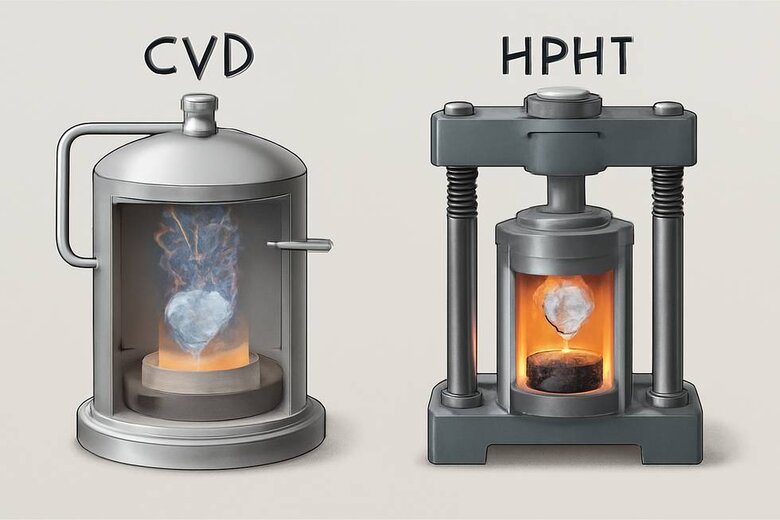
Sound complex? Here's what matters: Dual CVD/HPHT capabilities enable technology optimization based on specific requirements rather than production limitations.
CVD diamonds grow layer by layer through carbon atom deposition. Uniform crystal structure with predictable properties. Growth averaging 0.5-1.0mm per day enables precise size control.
HPHT replicates geological formation using industrial equipment subjecting carbon to extreme conditions. Rapid crystallization produces excellent clarity but less predictable color outcomes.
The bottom line? Laboratory analysis confirms both CVD and HPHT diamonds exhibit identical hardness, refractive index, and thermal conductivity to mined stones.
Budget optimization involves understanding technology advantages relative to design requirements. CVD often provides better value for color-critical applications. HPHT excels in clarity-focused designs.
Let's be direct: Informed selection based on application requirements rather than technology preference delivers optimal results for aesthetic and economic objectives.
"While both CVD and HPHT technologies are adept at producing high-quality lab-grown diamonds, it's crucial to recognize that the choice between them should be dictated not just by the diamond's intended use but also by environmental implications. The CVD process typically has a lower environmental impact due to its less energy-intensive nature compared to HPHT. This factor can be a decisive element for brands and consumers prioritizing sustainability alongside aesthetic and quality considerations."
Certification remains identical regardless of growth technology. IGI, GIA, and GCAL grading standards apply uniformly to both CVD and HPHT diamonds. This ensures eternity band quality meets professional standards independent of production method.
Frequently Asked Questions
Lab-grown eternity rings eliminate the 400-500% retail markups associated with traditional diamond distribution chains involving mines, rough dealers, cutting facilities, wholesalers, and retail stores. Manufacturer-direct purchasing combined with controlled laboratory production enables 70-90% savings while maintaining identical certification standards through IGI and GIA grading.
Without laboratory equipment, CVD and HPHT diamonds are visually indistinguishable as both exhibit identical hardness, refractive index, and thermal conductivity. CVD typically offers superior color consistency ideal for precise matching in eternity bands, while HPHT often produces larger crystals with exceptional clarity grades, though both technologies create genuine diamonds certified to the same professional standards.
Conflict-free certification guarantees diamonds originated from controlled laboratory environments rather than disputed mining regions, ensuring zero exploitation or funding of armed conflicts. Complete documentation tracks each diamond's laboratory origin through IGI and GIA certification bodies, providing supply chain transparency impossible with traditional mining operations where provenance can be difficult to verify.
Micro-pavé settings create unmatched continuous sparkle but require gentler handling during daily activities due to smaller prong structures holding tiny diamonds. Shared-prong settings offer superior durability for active lifestyles since larger diamonds are secured with more substantial metalwork, though they may create potential snag points on clothing—the choice depends on your lifestyle and aesthetic preferences.
Lab-grown diamonds currently carry lower resale values than mined equivalents, with many traditional jewelers offering minimal buyback prices. However, eternity bands rarely get resold as they represent permanent commitment symbols passed through generations rather than investment assets, and even mined diamonds typically recover only 20-40% of original retail prices—making the 70-90% upfront savings with lab-grown alternatives more valuable for most couples.
Select based on your design priorities rather than perceived quality differences, as both create genuine diamonds with identical properties. Choose CVD technology if precise color matching is critical for your eternity band design, as controlled gas environments produce superior color consistency. Opt for HPHT if you prioritize exceptional clarity grades and larger individual stones, though both technologies receive identical IGI and GIA certification.
Full circle settings require regular professional inspection to ensure diamond security since stones encircle the entire band including the underside exposed to daily wear. Clean your eternity band every 2-3 weeks using warm water and mild soap to maintain optimal light performance, as the continuous diamond placement relies on clean surfaces for internal reflection that creates the characteristic fire and brilliance.
Allow 4-6 weeks for custom eternity band creation to accommodate CVD or HPHT diamond growth cycles (which require weeks of controlled conditions), precision matching for color and clarity consistency, custom setting work, and final certification documentation. Manufacturer-direct operations maintain extensive inventory for faster turnaround on standard designs, but custom graduated sizing or specific celebrity-inspired configurations need additional production time.


